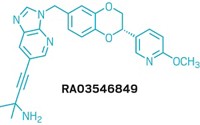Advertisement
Grab your lab coat. Let's get started
Welcome!
Welcome!
Create an account below to get 6 C&EN articles per month, receive newsletters and more - all free.
It seems this is your first time logging in online. Please enter the following information to continue.
As an ACS member you automatically get access to this site. All we need is few more details to create your reading experience.
Not you? Sign in with a different account.
Not you? Sign in with a different account.
ERROR 1
ERROR 1
ERROR 2
ERROR 2
ERROR 2
ERROR 2
ERROR 2
Password and Confirm password must match.
If you have an ACS member number, please enter it here so we can link this account to your membership. (optional)
ERROR 2
ACS values your privacy. By submitting your information, you are gaining access to C&EN and subscribing to our weekly newsletter. We use the information you provide to make your reading experience better, and we will never sell your data to third party members.
Pharmaceuticals
ACS Meeting News: New Tactics For Trouncing Migraine
Alternatives could overcome limitations of current drugs
by Carmen Drahl
October 1, 2007
| A version of this story appeared in
Volume 85, Issue 40

DESCRIPTIONS OF MIGRAINE'S debilitating symptoms occur early in recorded history, with an ancient Egyptian papyrus sarcastically recommending decapitation as the only viable treatment. Over time, gentler treatments for migraine sufferers, or migraineurs, emerged. Triptan drugs have helped thousands of migraineurs since their approval in the 1990s. Though hailed as a miracle, triptans have side effects and limitations. A session during the recent American Chemical Society national meeting in Boston highlighted alternatives beyond triptans for treating migraine.
Triptans reduce the dilation of brain arteries that contributes to intense migraine pain. Because constricting action caused by the compounds may affect blood vessels outside the brain, however, triptans aren't recommended for use by anyone with cardiovascular disease. That limitation, plus a need for faster-acting drugs, is motivating the search for migraine therapies with different modes of action.
The precise cause of migraines isn't clear, but they're more than just bad headaches. Many migraineurs experience pain on one side of the head and suffer from nausea, vomiting, and extreme sensitivity to light and sound. A quarter of migraineurs have nonpainful visual disturbances called auras.
Migraine treatment before sumatriptan, the first triptan, was largely ineffective because established pain-killers didn't selectively target migraine-specific pain pathways, explained Charles M. Conway, associate director of leadprofiling and applied biotechnology at Bristol-Myers Squibb. In contrast, researchers developing triptans knew that migraines seemed to be caused in part by changes in the level of the neurotransmitter serotonin. All seven Food & Drug Administration-approved triptans mimic serotonin's heterocyclic core and stimulate specific types of serotonin receptors to constrict blood vessels in the brain.
At the ACS Division of Medicinal Chemistry-sponsored symposium in Boston, participants discussed efforts to target signaling proteins other than serotonin receptors for migraine, namely, a receptor for a neuropeptide and a type of ion channel.
Paul L. Ornstein, senior research fellow at Eli Lilly & Co., and his team targeted iGluR5 and AMPA, two ligand-gated ion channels that respond to glutamate, an amino acid neurotransmitter. Glutamate has been implicated in the underlying mechanism of migraine aura as well as pain hypersensitivity. Blocking glutamate channels with a drug could therefore stave off pain without adverse cardiovascular effects, Ornstein suggested. "Triptans are an adequate treatment for migraine, but there is room for improvement," said Ornstein, who is a migraineur.
One of the most promising candidates to come out of Lilly's efforts is LY293558, an iGluR5/AMPA antagonist with a decahydroisoquinoline skeleton that didn't constrict blood vessels in a rabbit model. In a Phase IIa study, intravenous LY293558 was as effective as sumatriptan injection at providing pain relief and elicited fewer side effects. Lilly licensed LY293558, now called tezampanel, to TorreyPines Therapeutics. That company plans to report the results of a Phase IIb acute migraine clinical trial of injected tezampanel in the fourth quarter of 2007.
Two speakers focused on another migraine-relief strategy—preventing calcitonin gene-related peptide (CGRP) from activating its receptor. A clear association exists between migraine pain and the release of this peptide in the brain. Molecules that block CGRP receptors are expected to deliver pain relief by normalizing dilated blood vessels in the brain without triptanlike vessel constriction.
Theresa M. Williams, director of medicinal chemistry at Merck Research Laboratories in West Point, Pa., discussed her group's orally administered CGRP receptor antagonist, MK-0974, which was first reported at the ACS national meeting in Chicago (C&EN, May 7, page 56) and is now in Phase III trials.
Describing earlier-stage discovery efforts, Prasad Chaturvedula, senior principal scientist for neuroscience chemistry at Bristol-Myers Squibb, in Wallingford, Conn., reported Compound X, which blocks the effects of CGRP in a marmoset migraine model in as little as 15 minutes after dosing by injection. Chaturvedula also described a second-generation inhibitor called Compound Y, whose structure he did not disclose.
"The promise of fast pain relief is very appealing in the migraine area," said session organizer Gene M. Dubowchik, associate director of neuroscience chemistry at Bristol-Myers Squibb.
THE NEED for rapid onset of action has encouraged researchers to consider drug delivery options other than pills. At the meeting, James V. Cassella, senior vice president at Alexza Pharmaceuticals, described an inhaler that could make migraine relief just a breath away.
Alexza's device, which is about the size of a small cell phone, houses an inner surface that's spray-coated with a drug. When triggered by human breath, the surface quickly heats up, vaporizing the drug, which then speeds into the bloodstream through the lungs. Cassella noted that about half of 400 medicinal substances tested appeared to be deliverable with Alexza's technology.
The company is now conducting clinical trials of an inhaler spray-coated with prochlorperazine, an intravenous drug that's been used in emergency rooms to treat migraine for about 10 years. A Phase IIb trial demonstrated that inhaled prochlorperazine could provide two to 24 hours of sustained pain relief for patients in the throes of migraine, Cassella reported.
The research presented in the session is laying a foundation for understanding the origins and progression of migraine pain, Conway emphasized. "The emerging players highlight the underlying mechanisms that are important to control for an effective migraine therapy," he said.
Related Stories
- Pharmaceutical Revelations
- May 7, 2007




Join the conversation
Contact the reporter
Submit a Letter to the Editor for publication
Engage with us on Twitter